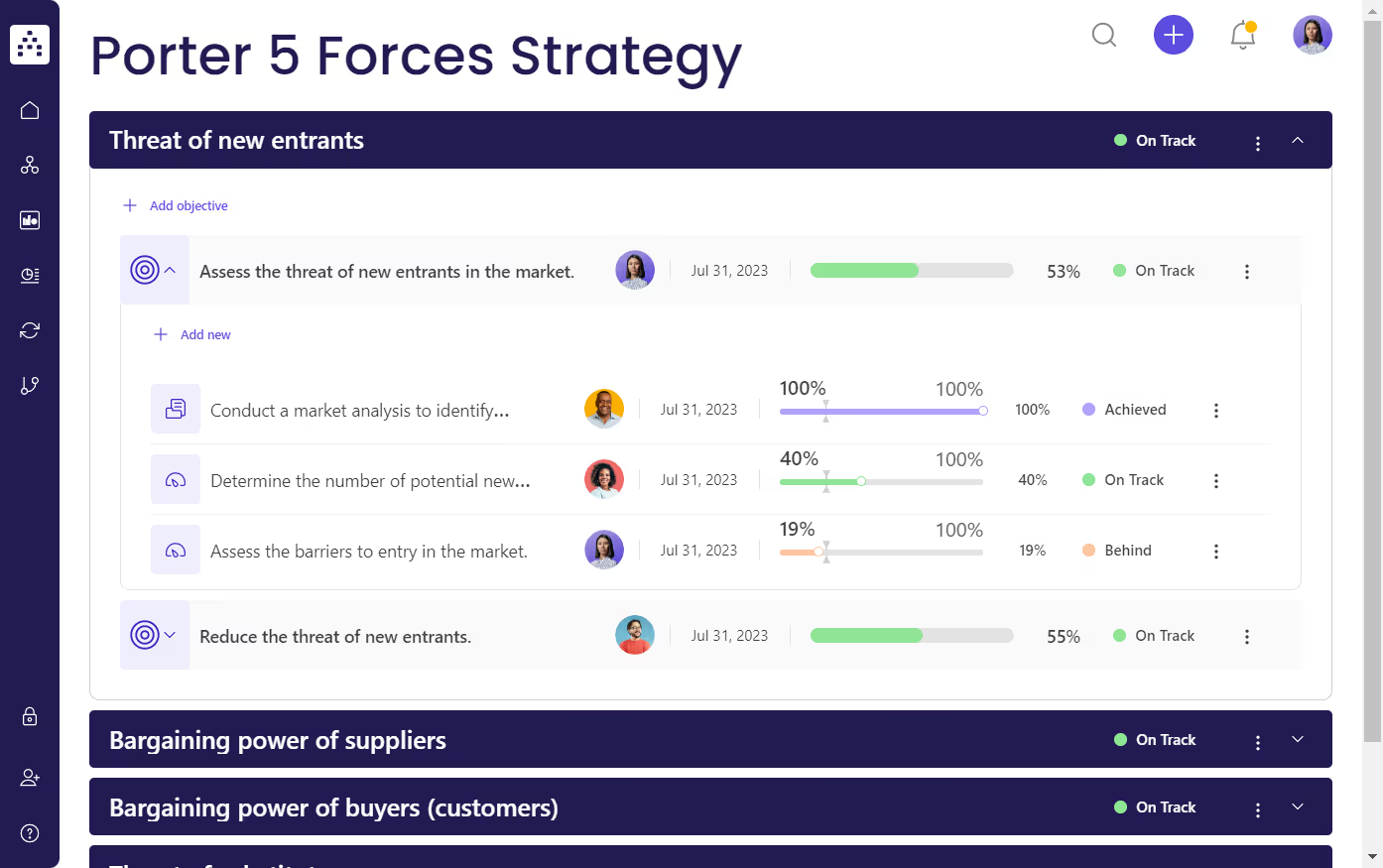What is the Porter 5 Forces framework?
Porter 5 Forces is a framework for analyzing competitive forces in a market. It helps organizations to understand the key forces that shape their industry and how to leverage these forces for competitive advantage.
What's included in this Porter 5 Forces Template template?
- 5 focus areas
- 6 objectives
- 6 projects
- 6 KPIs
Each focus area covers a critical aspect of the competitive landscape that businesses need to consider in order to succeed, associated with its own objectives, projects, and KPIs to ensure that the strategy is comprehensive and effective.
Who is the Porter 5 Forces Template for?
This Porter 5 Forces Strategy Template is designed for leaders and teams from organizations that want to gain a better understanding of their industry's competitive forces and use these findings to craft a winner strategic plan based on the Porter 5 Forces pillars:
- Threat of new entrants
- Bargaining power of suppliers
- Bargaining power of buyers (customers)
- Threat of substitutes
- Competitive rivalry
It's for those who want to take a strategic approach to their business and stay ahead of the competition.
How is this Porter 5 Forces Template relevant to your organization?
This Porter 5 Forces Template can help your organization to identify threats and opportunities, improve decision-making, and gain a competitive advantage. It provides a clear and structured framework to analyze the competitive landscape and develop effective strategies for success. Whether you're looking to launch a new product, expand into new markets, or simply stay ahead of the competition, this template can help you achieve your goals.
1. Define clear examples of your focus areas
Focus areas are the broad topics that your project portfolio strategy plan should address. The focus areas in this template relate to the five forces proposed by this framework: Threat of new entrants; Bargaining power of suppliers; Bargaining power of buyers (customers); Threat of substitutes; Competitive rivalry.
It is important to associate each focus area with its own objectives and KPIs so you can measure progress towards your goals and ensure successful strategy execution.
2. Think about the objectives that could fall under that focus area
Objectives are the goals and outcomes that your team is trying to achieve within each focus area. Objectives should be specific, measurable, and achievable, and they should be broken down into smaller steps that can be tracked and measured.
For example, under the focus area of Threat of new entrants, objectives may include "Assess the threat of new entrants in the market", and "Reduce the threat of new entrants".
3. Set measurable targets (KPIs) to tackle the objective
KPIs, or key performance indicators, are measurable targets that allow you to track progress towards your objectives. These targets should be specific and measurable, such as Increase the number of suppliers by 20%, or Reduce supplier costs by 10% - in this case associated with the focus area of Bargaining power of suppliers.
Setting measurable targets helps ensure that your team is tracking progress and can make adjustments as needed.
4. Implement related projects to achieve the KPIs
Actions, or projects, are the steps that your team needs to take in order to achieve the KPIs and objectives that you have set. These actions should be specific and achievable to help ensure success. Examples of actions may include Conducting a customer analysis to identify customer power for the focus area of Bargaining power of buyers (customers); or Differentiate products and create brand loyalty.
5. Utilize Cascade Strategy Execution Platform to see faster results from your strategy
Cascade Strategy Execution Platform is a powerful tool that can help teams create and execute their strategic plans. Cascade helps teams track objectives, measure progress, and quickly make adjustments to ensure success. With Cascade, teams can see faster results from their strategy and leverage the Porter 5 Forces Framework in an easy-to-use template for greater performance.


